
Cover of Luke Vincent Lockwood’s Colonial Furniture in America (New York: Charles Scribner’s Sons, 1901; photo, Gavin Ashworth). The first edition of this milestone publication featured cover art derived from the “Hartford chests” Lockwood so admired. A “Hadley chest” illustrates the title page, and the frontis features a highly stylized “Portsmouth” blockfront. Although the text is far from exclusive in its emphasis on regional styles, there has never been an American furniture survey that balanced the regional and the cosmopolitan more equally.

Portrait of Homer Eaton Keyes, ca. 1925. (Courtesy, Antiques.)

Frontis of Albert Sack’s Fine Points of Furniture: Early American (New York: Crown Publishers, 1950). (Courtesy of Sack Heritage Group; photo, Gavin Ashworth.) www.sackheritagegroup.com

Governor’s Palace dining room as furnished ca. 1950. (Courtesy, Colonial Williamsburg Foundation.)

Governor’s Palace dining room as furnished ca. 1980. (Courtesy, Colonial Williamsburg Foundation.)

Furniture exhibit in the DeWitt Wallace Decorative Arts Gallery, ca. 1988. (Courtesy, Colonial Williamsburg Foundation.)

Connecticut Furniture, Wadsworth Atheneum, 1967. In addition to its role as a catalyst for the study of regional furniture, this exhibition was also the first to display furniture on high pedestals as “art.” John Kirk designed the installation.

Portrait of Alice Winchester, ca. 1970. (Courtesy, Antiques.)

Arts of the Pennsylvania Germans, Special Exhibition, Philadelphia Museum of Art and Winterthur Museum, 1983. (Courtesy, Philadelphia Museum of Art.)
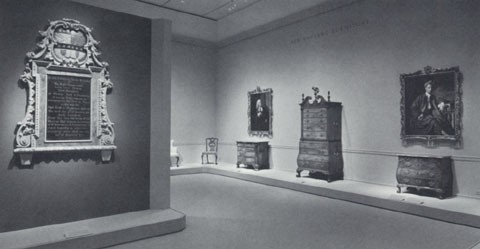
American Rococo, 1750-1775: Elegance in Ornament, held at the Metropolitan Museum of Art, Jan. 26-May 17,1992. (Courtesy, The Metropolitan Museum of Art, all rights reserved.)

The Great River, Wadsworth Atheneum, 1985. (Courtesy, Wadsworth Atheneum.)

China table attributed to Robert Harrold (fl. 1765-1792), Portsmouth, 1765–1775. Mahogany and mahogany veneer with maple and white pine. H. 28 5/8", W. 36 1/4", D. 22 7/16". (Courtesy, Carnegie Museum of Art; museum purchase, Richard King Mellon Foundation grant, acc. 72.55.2.)
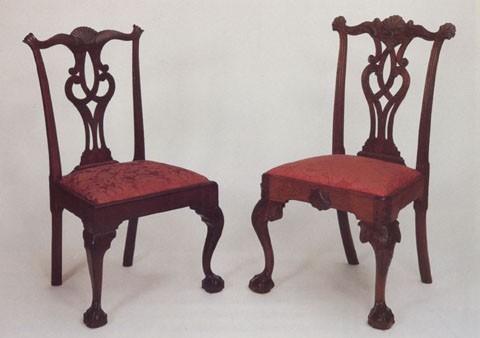
East Windsor and Philadelphia compared: Left: Side chair, attributed to Eliphalet Chapin, East Windsor, Connecticut, ca. 1780. Cherry with pine. H. 38", W. 22 3/4", D. 18". Right: Side chair, Philadelphia, ca. 1755. Mahogany with pine. H. 40 1/4", W. 23 1/2", D. 18 1/2". (Courtesy, Wadsworth Atheneum; Hartford. Gift of Mrs. Gordon W. Russell [left]. Gift of Samuel P. Avery [right].) Eliphalet Chapin made “Philadelphia chairs” for a Connecticut market. They were related in proportions, construction, and form, but different in materials and decorative details.
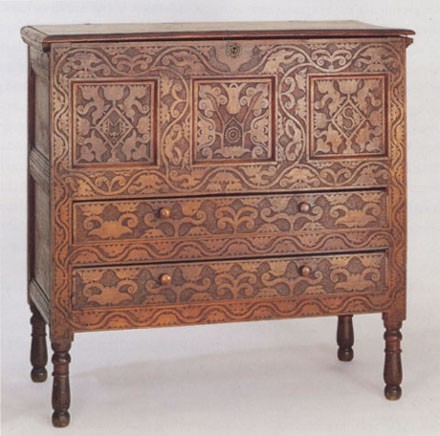
Chest with drawers, probably Hadley, Massachusetts, 1695–1700. Maple with pine. H. 45 1/8", W. 43 1/2", D. 19 3/4". (Courtesy, Wadsworth Atheneum; Evelyn Bonar Storrs Trust Fund and gift of J. Pierpont Morgan, by exchange, acc. 1991.18.) This chest is presumed to be the earliest of several variants of the “Hadley chest” produced in the mid-Connecticut Valley between about 1685 and 1730. This example is the most similar to carved chests from the Wethersfield, Hartford, and Windsor vicinity and is believed to have been adapted by joiners from that area.
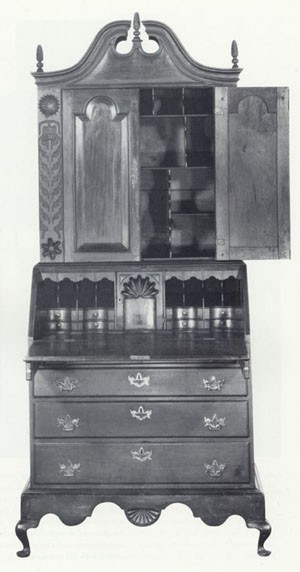
Desk-and-bookcase, Hampshire County, Massachusetts, ca. 1775. Cherry with pine. H. 82 3/4", W. 35 1/2", D. 19 3/4". (From the Collections of Henry Ford Museum and Greenfield Village, Copy and Reuse Restrictions Apply.)

Door, circa 1750, from the Daniel Fowler house, Westfield, Massachusetts,. (Courtesy, The Metropolitan Museum of Art, Rogers Fund, 1916. (16.147) Photo, Gavin Ashworth.)

Gravestone of Samuel Pease, possibly made by Ezra Stiles, Enfield, Connecticut, 1770. (Photo, William Hosley.)

Cupboard in the Dr. Alexander King House, attributed to Eliphalet King, Suffield, Connecticut, ca. 1764. (Courtesy, Suffield Historical Society.)

Gravestone of John Thrall, carved by Phineas Newton, East Granby, Connecticut, 1791. (Photo, William Hosley.)

Gravestone of Mehetabel Smith, Hadley, Massachusetts, 1770. (Photo, William Hosley.)

Detail of the pilaster of a high chest of drawers attributed to Eliakim Smith, Hadley, Massachusetts, ca. 1770. Cherry with white pine. H. 89 3/4", W. 39 15/16", D. 20 3/8". (Courtesy, Historic Deerfield, Inc. photo, Amanda Merullo.) www.historic-deerfield.org

Chest-on-chest, southern New Hampshire, ca. 1780. Maple with pine. H. 89", W. 40 5/8", D. 19 7/8". (Courtesy, The Currier Gallery of Art, Manchester, New Hampshire. Museum purchase: George A. Leighton Fund, 1960.7; photo, Frank Kelly).
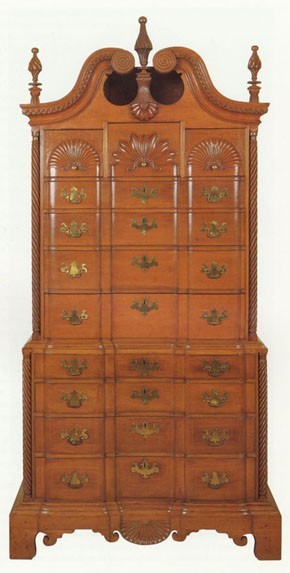
Chest-on-chest on frame by Samuel Loomis, Colchester, Connecticut, ca. 1775. Mahogany with pine. H. 88", W. 45", D. 26". (Courtesy, Wadsworth Atheneum; gift of Mr. and Mrs. Arthur L. Shipman, acc.1967.140.)


Cupboard and case of drawers, Mount Lebanon, New York, ca. 1820. Painted pine with fruitwood knobs. H. 96", W. 54", D. 14". (Courtesy, Mount Lebanon Shaker Collection. Circulated by Art Services International, Alexandria, Virginia.)

Gibson House, Canandaigua, New York, ca. 1820. (Courtesy, Ontario County Historical Society.)

George West house, Irasburg, Vermont, 1824–1834. (Courtesy, Middlebury College and Erik Borg.) This is one of a group of houses built in the upper Connecticut Valley from the mid-1820s until about 1850. The earliest examples appear to have originated in the northern part of the state and may have roots in French Canadian building practices.
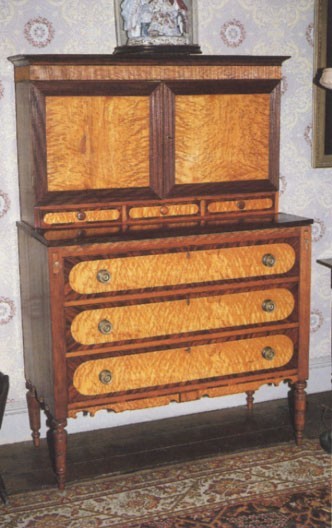
Desk-and-bookcase, Middlebury, Vermont, ca. 1820, Maple and cherry with pine. (Courtesy of the Henry Sheldon Museum of Vermont History, Middlebury, Vermont.) Although the contrasting veneers of this desk-and-bookcase are stylistically related to cabinetwork from Portsmouth, New Hampshire, it is part of a group of western Vermont furniture distinguished by brilliantly figured curley and bird’s-eye maple panels and veneers.

Desk-and-bookcase by John Shearer, Martinsburg, West Virginia, 1801 (desk) and 1806 (bookcase). Walnut, cherry, and mulberry with yellow pine and oak. H. 106", W. 45", D. 24 1/2". (Collection of the Museum of Early Southern Decorative Arts, Winston-Salem, North Carolina.)
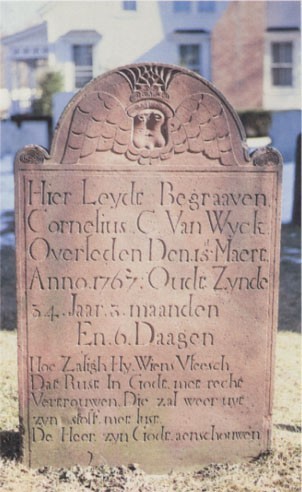
Gravestone of Cornelius C. Van Wyck, Fishkill, New York, 1767. (Photo, William Hosley.)

Gravestone of Catherina Elserin, Adamstown, Pennsylvania, 1793. (Photo, William Hosley.)

German Palatine Church, Stone Arabia, New York, 1770 with tower about 1805. (Photo, William Hosley.)
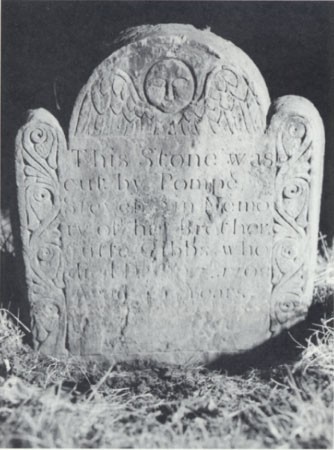
Gravestone of Cuffe Gibbs by Pompe Stevens, Common Burying Ground, Newport, Rhode Island, 1768. (Photo, William Hosley.) The several dozen stones marking the graves of African slaves in Newport’s largest colonial burying ground is the largest concentration in New England. This stone is signed by an African American stonecutter, Pompe Stevens, who probably worked in the shop of John Stevens, Newport’s most skilled and prolific stonecutter.

Gravestone of Dr. John Henry Burchsted, Lynn, Massachusetts, 1721. (Photo, William Hosley.) This prominent physician was from Silesia, and his gravestone is one of the most expensive from its time.

Gravestone of James Park, Groton, Massachusetts, 1778. (Photo, William Hosley.) The Park family of Groton were a multigenerational dynasty of Scotch stonemasons.
